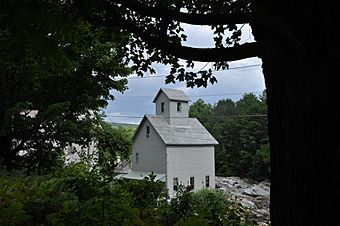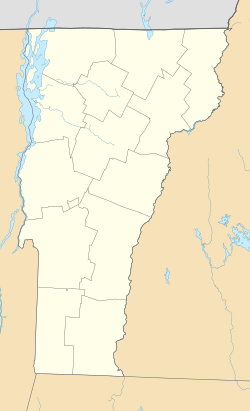Kingsley Grist Mill Historic District facts for kids
Quick facts for kids |
|
|
Kingsley Grist Mill Historic District
|
|

The Kingsley Mill
|
|
| Location | East St. & Gorge Rd., Clarendon, Vermont |
|---|---|
| Area | 3 acres (1.2 ha) |
| Built | 1778 |
| Architect | Powers, Nichols Montgomery; Horton, Timothy K. |
| Architectural style | Federal, Queen Anne |
| NRHP reference No. | 07001170 |
| Added to NRHP | November 8, 2007 |
The Kingsley Grist Mill Historic District is a special place in Clarendon, Vermont. It's home to an old mill complex that looks much like it did in the late 1800s. You can find it where Gorge Road and East Road meet. This area includes a house, a barn, the mill itself, and other small buildings. The nearby Kingsley Covered Bridge is also part of this historic district. Because it's so well-preserved, this district was added to the National Register of Historic Places in 2007. This means it's recognized as an important historical site.
Contents
What is the Kingsley Grist Mill?
The Kingsley Grist Mill complex is located in Vermont, not far from the Rutland Southern Vermont Regional Airport. It covers about 3 acres of land. The site has several old buildings. These include a house built around 1778 and a horse barn from 1885. Most of the mill buildings you see today were built in the 1880s.
The district also includes parts of an older mill and its dam. This dam was made of timber. Sadly, a big flood in 1927 washed away most of its main structure. An old road that once connected Clarendon to Shrewsbury is also thought to run through the property. Today, this old road serves as the main driveway for the complex.
History of the Mill and its Owners
The story of the Kingsley Grist Mill begins in 1778.
Who Built the First Mill?
The first house on the property was built around 1778. It was built by Nathaniel Crary. He was a brave soldier who fought in the American Revolutionary War. Nathaniel Crary also built the very first mills on this site. However, these early mills faced a challenge. A big flood in 1818 destroyed them.
How the Kingsley Family Took Over
In 1825, Nathaniel Crary sold the property. It was bought by Chester Kingsley. Chester then built new mills on the site. His son, Horace Kingsley, made the house even bigger around 1835.
The Kingsley family continued to operate the mills. In 1869, another flood destroyed Chester Kingsley's carding mill. A carding mill was used to prepare wool for spinning. The grist mill, which grinds grain into flour, was improved many times during the 1800s.
Rebuilding and Operation
Later, the grist mill was completely rebuilt for John Kingsley. The new mill was built by Nichols Powers. He was famous for building covered bridges. The Kingsley family kept the grist mill running until 1935. It was an important part of the community for many years.



